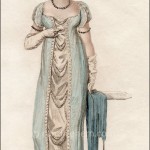Journal de Dames et des Modes, Paris, December 20, 1814.
 “Turban de Mousseline, par-dessus de Cachemire.”
“Turban de Mousseline, par-dessus de Cachemire.”
This is such a pretty dress. But the only description, which is below the print, is for the headdress. This is an evening dress for which I would really like to have more information. Let’s see what we can figure out just by examining the image.
The description tells us that the turban, which is quite simple, is made of muslin, above a cap or bandeau of cashmere. It’s December, so cashmere would be appropriate. The necklace and earrings look to be made of drop pearls.
The under-dress, white in color and likely muslin, is trimmed at the bottom with three rows of vandykes. The top of the under-dress bodice, which appears to be gathered, is seen beneath the deep V of the over-dress.
The over-dress, or robe, is pretty spectacular. Since it is winter, one wonders if it might also be made of cashmere. It is white, three-quarter length, with lovely trimming in shades of green and pink long the edge of the bodice and epaulettes, under the high waist, in a double row down the front of the dress, and outlining a floral pattern at the base of the dress. I would guess the trimmings are embroidered.
The white shoes are sandals, meaning they laced above the ankle, with a tiny bow at the vamp. I suspect the sandals are made of satin, as would be appropriate for an evening dress.
This print was designed, and signed, by Horace Vernet, and engraved by Pierre Baquoy, both famous Parisian artists.







